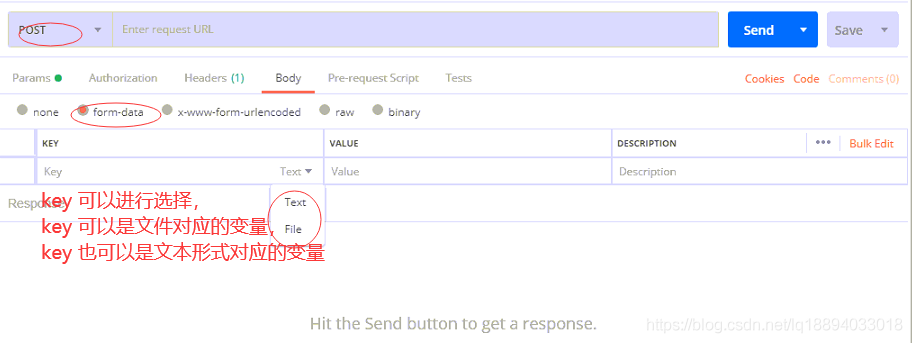今天就跟大家聊聊有关postman模拟post请求的四种请求体分别是什么,可能很多人都不太了解,为了让大家更加了解,小编给大家总结了以下内容,希望大家根据这篇文章可以有所收获。
1.application/x-www-form-urlencoded
浏览器的原生 表单,其中ajax也是用这种方式提交的,主要是key-value 键值对的形式。一般的请求方式如下图所示:

POST HTTP/1.1Host: test.app.comContent-Type: application/x-www-form-urlencodedCache-Control: no-cachePostman-Token: e00dbaf5-15e8-3667-6fc5-48ee3cc89758key1=value1&key2=value2POST中(application/x-www-form-urlencoded)请求方式截图,主要在key中传入接口中定义的变量,value 中传入值就可以进行测试接口
2.multipart/form-data
它会将表单的数据处理为一条消息,以标签为单元,用分隔符分开。既可以上传键值对,也可以上传文件。
由于有boundary隔离,所以multipart/form-data既可以上传文件,也可以上传键值对,它采用了键值对的方式,所以可以上传多个文件,在springmvc中可以使用MultipartHttpServletRequest接收通过api根据"name"获取不同的键值,也可以通过MulTipartFile数组接收多个文件。
POST HTTP/1.1Host: test.app.comCache-Control: no-cachePostman-Token: 59227787-c438-361d-fbe1-75feeb78047eContent-Type: multipart/form-data; boundary=----WebKitFormBoundary7MA4YWxkTrZu0gW------WebKitFormBoundary7MA4YWxkTrZu0gWContent-Disposition: form-data; name="filekey"; filename=""Content-Type: ------WebKitFormBoundary7MA4YWxkTrZu0gWContent-Disposition: form-data; name="textkey"tttttt------WebKitFormBoundary7MA4YWxkTrZu0gW--

PSOT同时上传文件和键值对数据
3. raw
可以上传任意格式的文本,可以上传text、json、xml、html等Controller接口可以通过@RequestBody 来修饰,传入数据就是JSON格式
注意: 在使用raw 方式,如果在PostMan再测试的时候需要在headers中添加一个key-value (Content-Type: application/json 或者对应的格式)

4.binary
相当于Content-Type:application/octet-stream,从字面意思得知,只可以上传二进制数据,通常用来上传文件,由于没有键值,所以,一次只能上传一个文件。

POST HTTP/1.1Host: test.app.comCache-Control: no-cachePostman-Token: 5ad66f08-6faa-aba0-744a-ca958b1a0fc2undefined 提醒:
multipart/form-data与x-www-form-urlencoded区别:
html中的form 表单有两种:application/x-www-form-urlencoded和multipart/form-data。application/x-www-form-urlencoded是默认的MIME内容编码类型,它在传输比较大的二进制或者文本数据时效率极低。
MIME:
简单说,MIME类型就是设定某种扩展名的文件用一种应用程序来打开的方式类型。服务器会将它们发送的多媒体数据的类型告诉浏览器,而通知手段就是说明该多媒体数据的MIME类型,服务器将 MIME标志符放入传送的数据中来告诉浏览器使用哪种插件读取相关文件。
multipart/form-data:既可以上传文件等二进制数据,也可以上传表单键值对,只是最后会转化为一条信息。当设置multipart/form-data,http会忽略 contentType 属性。
x-www-form-urlencoded:只能上传键值对,不能用于文件上传。不同的field是用&区分开的。这两个类均实现了HttpEntity接口,使用如下:
public static String testUpload(String url) { String result = null; CloseableHttpClient httpclient = HttpClients.createDefault(); HttpPost httppost = new HttpPost(url); try { FileBody bin = new FileBody(new File("F:\\image\\sendpix0.jpg")); StringBody comment = new StringBody("A binary file of some kind", ContentType.TEXT_PLAIN); HttpEntity reqEntity = MultipartEntityBuilder.create().addPart("bin", bin).addPart("comment", comment) .build(); httppost.setEntity(reqEntity); System.out.println("executing request " + httppost.getRequestLine()); CloseableHttpResponse response = httpclient.execute(httppost); try { int statusCode = response.getStatusLine().getStatusCode(); if (statusCode == HttpStatus.SC_OK) { result = EntityUtils.toString(response.getEntity(), "UTF-8"); } } finally { response.close(); httpclient.close(); } } catch (ClientProtocolException e) { e.printStackTrace(); } catch (IOException e) { e.printStackTrace(); } finally { try { httpclient.close(); } catch (IOException e) { e.printStackTrace(); } } return result; } public static String testParam(String url) { String result = null; CloseableHttpClient httpclient = HttpClients.createDefault(); httpclient = HttpsHelper.newHttpsCloseableClient(); HttpPost httpPost = new HttpPost(url); List<NameValuePair> params = new ArrayList<NameValuePair>(); params.add(new BasicNameValuePair("key1", "value1")); params.add(new BasicNameValuePair("key2", "value2")); try { httpPost.setEntity(new UrlEncodedFormEntity(params)); httpPost.setConfig(requestConfig); CloseableHttpResponse httpResp = httpclient.execute(httpPost); try { int statusCode = httpResp.getStatusLine().getStatusCode(); if (statusCode == HttpStatus.SC_OK) { result = EntityUtils.toString(httpResp.getEntity(), "UTF-8"); } } finally { httpResp.close(); httpclient.close(); } } catch (UnsupportedEncodingException e) { e.printStackTrace(); } catch (ClientProtocolException e) { e.printStackTrace(); } catch (IOException e) { e.printStackTrace(); } finally { try { httpclient.close(); } catch (IOException e) { e.printStackTrace(); } } return result; }看完上述内容,你们对postman模拟post请求的四种请求体分别是什么有进一步的了解吗?如果还想了解更多知识或者相关内容,请关注编程网行业资讯频道,感谢大家的支持。




